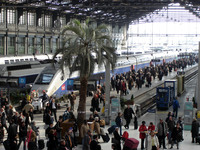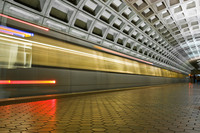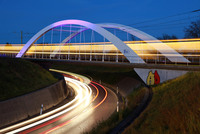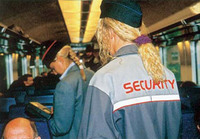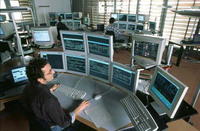Home / edito / Project structure
Project structure

GENERAL STRUCTURE
The project has been structured in 7 Sub-Projects and 38 Work Packages.
The 5 technical SPs are supported by the Project Management & Technical
Coordination (SP0) and Dissemination and Exploitation (SP1) subprojects.
For each sub-mission considered, the functional & technical specifications for prevention, mitigation and crisis management will be defined (SP2) for the selected scenarios at the sub-mission level and at global integration level.
In SP3 and SP4, (for fixed assets and transported assets) will be demonstrated the feasibility of solving the identified railway protection submissions through an efficient and cost effective integration of technologies. Closely reflecting the main needs in the railway sector, these sub-missions will focus on protection of key assets.
SP5 will then propose a coherent architectural and design framework for the sub-missions and integrate them in a global demonstration
Finally SP6 will consider political, economical, social-cultural aspects beside the technological ones to drive towards future design for security strategies
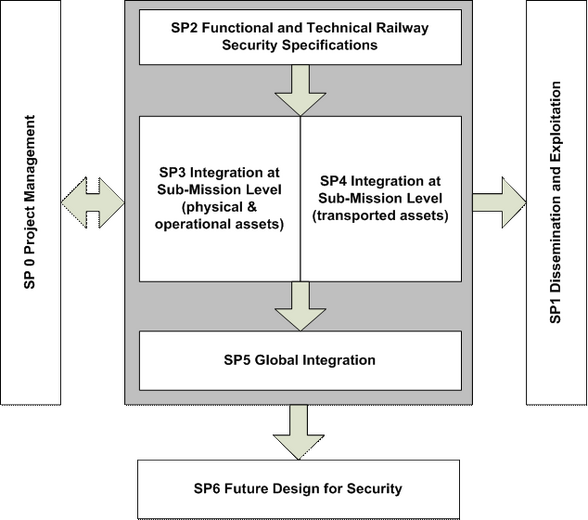
The project will be carried out by:
-
- considering the specificity of rail environment;
- monitoring the impact of security measures on ethical issues and citizens rights;
- considering the positive impacts against other forms of threats and for mitigation of consequences of natural events.
SP1
Dissemination and Exploitation - led by UIC/UNIFE
SP1 will guarantee proper diffusion of knowledge and projects results inside and outside the Consortium.
- Implementation of a dedicated PROTECTRAIL workspace in the UIC Knowledge Management System and implementation of a public website
- Definition of the relevant user-groups and contacts required to cover the decision-making process
- Inventory/participation to relevant international events
- Organization of regular thematic workshops.
- Production of dissemination material: newsletter, posters, flyers, etc.
- Elaboration of an exploitation plan and redaction of an exploitation report
SP2
Functional and Technical Railway Security Specification - led by ASTS/THALES
SP2 will generate a set of functional and technical specifications for the project missions, considering:
- needs and priorities of railway stakeholders and/or having significant impact on railway security policies
- the fundamental human right to privacy of passengers
SP2 will refine requirements and specifications during project’s life
- to take into account possible variations due to changed environmental conditions/technological evolution
- to constantly verify the compatibility of the scenarios with the fundamental passengers right to privacy;
- to provide stakeholders’ advice on and feedback to SP3, SP4 and SP5
SP3
Integration at Sub-Mission Level (physical & operational assets) - led by ALSTOM/TNO
SP3 will demonstrate the feasibility of solving the identified railway protection sub-missions through an efficient and cost effective integration of technologies.
Closely reflecting the main needs in the railway sector, these sub-missions will focus on protection of key assets:
- stations and buildings;
- structures;
- tracks;
- signalling, interlocking, command & control, power distribution;
- communications and informationsystems;
- rolling stock clearance;
- staff clearance.
SP4
Integration at Sub-Mission Level (transported assets) - led by THALES 3S/Elsag Datamat
SP4 will design and develop in-laboratory proof-of-concept performance prototypes able to demonstrate the feasibility of the protection of transported assets.
SP4 is split into 4 Work Packages, featuring 4 sub-missions:
- passenger clearance control: improved detection of threats (e.g. NRBC, hidden object on people, tracking people, abandoned object detection…) as well as abnormal situations on board or just before boarding;
- luggage clearance control: improved detection of threats like explosive devices or other suspicious devices in ordinary baggage
- freight clearance control: improved detection and discrimination of threats introduced into transported freight;
- tracking and control of rolling stock for threats from transported freight
SP5
Global Integration - Led by Bombardier Transport / Selex Systemi Integrati
SP5 will integrate the set of functional and technical results, developed in SP3 and SP4 at sub-mission level, taking into account security requirements defined in SP2.
This integration will define a system design, specifying the interfaces onboard of trains and within the railway infrastructure System design and will enable train to way-side integration, both for the passenger and the freight markets to set rules for system interoperability between different fleets, and railway operators, across different European countries.
SP5 will propose a coherent architectural and design framework to allow a futureproof affordable deployment
SP6
Future Design for Security - Led by TNO/SARAD
SP6 will describe a vision of the long term evolution of the future railway security
system as result of various influence factors and their mutual interactions. The long term foresight
of the railway security allows not only a forward view to the future evolution but it can also be used
for a view from an imaginary point of time in 10-20 years backward to the presence. That backward view allows the evaluation of long-term investments (which must be taken in the presence) with respect to their usefulness during the following years.
In particular, the following steps are necessary:
- estimation of the relevant internal (steerable) and external (non-steerable) influence PEST (Political, Economical, Socio-cultural and Technological) factors of the railway security system (Internal factors could be affected by the operators, external factors like passenger preferences not);
- estimation of the future developments of each of the selected influence PEST-factors as
function of time; - estimation of mutual interactions between the influencing PEST-factors (common with UIC);
- Selection of those influence factors which determinates the future evolution of the railway
security system; - development of possible e.g. alternative scenarios of future railway security system;
- extension of the system model by future (PEST) parameters influencing the common security
aspects (e.g. intelligence, detection, neutralization, mitigation, protection and crisis
management) against threats; - design of a future security system.




